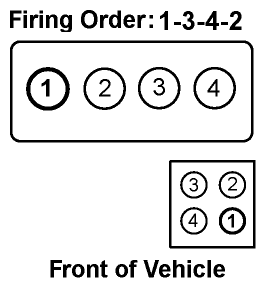The 2013 Mazda CX-5 was the first model year for this popular crossover SUV, introducing Mazda’s SkyActiv technology, which prioritizes performance, fuel efficiency, and reliability. At the heart of this model lies the 2.0L SkyActiv-G inline-4 engine, a powertrain that continues to be praised for its smooth operation. A crucial aspect of this engine’s design is its firing order.
In this guide, we’ll explore the firing order of the 2013 Mazda CX-5 engine, explain why it matters, and discuss how it impacts the engine’s performance. Whether you’re a DIY mechanic, a Mazda owner, or just curious about your car’s internals, this article will break it all down in a conversational and easy-to-follow tone.

Quick Navigation
The 2013 Mazda CX-5 Firing Order
The firing order for the 2013 Mazda CX-5’s 2.0L SkyActiv-G engine is: 1-3-4-2

How the Firing Order Works
- Cylinder 1 Fires First: The ignition sequence starts with the frontmost cylinder.
- Cylinder 3 Fires Next: Ignition moves to the third cylinder, skipping the second.
- Cylinder 4 Fires Third: The fourth (rearmost) cylinder ignites next.
- Cylinder 2 Fires Last: Finally, the second cylinder fires, completing the cycle.
This sequence ensures that the combustion process alternates between cylinders in a way that balances power delivery and minimizes engine vibration.
What Is a Firing Order?
The firing order refers to the specific sequence in which the engine’s spark plugs ignite the air-fuel mixture in its cylinders. This ignition process creates the controlled explosions that power the engine. In every engine, the firing order is carefully designed to optimize performance, balance, and efficiency.
Why Is the Firing Order Important?
- Smooth Operation: A proper firing order minimizes vibrations and allows the engine to run smoothly.
- Efficiency: Correct timing ensures complete combustion, improving fuel economy and reducing emissions.
- Performance: Balanced power delivery results in a responsive and powerful driving experience.
- Longevity: A well-balanced engine reduces wear and tear on internal components.
Overview of the 2013 Mazda CX-5 Engine
The 2013 Mazda CX-5 features a 2.0L SkyActiv-G inline-4 engine, part of Mazda’s innovative SkyActiv family. This engine is designed to optimize thermal efficiency, reduce weight, and improve fuel economy without compromising power.
Engine Configuration
- Inline-4 Layout: The engine has four cylinders arranged in a straight line.
- Displacement: 2.0 liters, delivering 155 horsepower and 150 lb-ft of torque.
- Compression Ratio: A high compression ratio of 13:1, enhancing efficiency and power output.
Cylinder Numbering
In an inline-4 engine like the one in the CX-5, the cylinders are numbered sequentially:
- Cylinder 1: Frontmost cylinder (closest to the belts and pulleys).
- Cylinder 2: Second cylinder from the front.
- Cylinder 3: Third cylinder from the front.
- Cylinder 4: Rearmost cylinder (closest to the transmission).
Why Mazda Uses the 1-3-4-2 Firing Order
The 1-3-4-2 firing order is a common choice for inline-4 engines due to its efficiency and balance. Here’s why it’s effective:
- Balanced Combustion: Alternating ignition between cylinders reduces stress on the crankshaft and prevents excessive vibrations.
- Consistent Power Delivery: The sequence ensures there’s always a cylinder in the power stroke, leading to smooth and steady performance.
- Optimized Efficiency: The firing order supports efficient airflow and combustion, crucial for the SkyActiv-G engine’s high compression ratio.
Identifying the Firing Order
If you’re working on your Mazda CX-5 engine, it’s important to verify the firing order. Here’s how you can do that:
Consult the Owner’s Manual
The owner’s manual provides detailed specifications, including the firing order and cylinder numbering.
Check the Engine Block
Cylinder numbers are often marked near the spark plugs or on the engine block itself, making it easier to trace the firing order.
Use a Service Manual
Professional repair manuals include diagrams and instructions specific to the 2013 Mazda CX-5, which can help you understand the engine’s ignition sequence.
Symptoms of Incorrect Firing Order
An incorrect firing order can lead to noticeable performance issues. If the spark plugs ignite out of sequence, you may experience these symptoms:
Common Symptoms
- Engine Misfires: Cylinders fail to fire correctly, causing rough performance and inconsistent power delivery.
- Rough Idling: The engine vibrates or feels unstable when idling.
- Loss of Power: The car struggles to accelerate or maintain speed.
- Unusual Sounds: Knocking, backfiring, or other irregular noises can occur.
- Increased Fuel Consumption: Inefficient combustion results in higher fuel usage and emissions.
Causes of Firing Order Problems
- Misconnected Spark Plug Wires: Spark plug wires connected in the wrong order can disrupt the firing sequence.
- Faulty Ignition Components: Damaged spark plugs, ignition coils, or sensors can interfere with proper ignition timing.
- Timing Chain Issues: A misaligned timing chain can throw off the engine’s synchronization.
Diagnosing and Fixing Firing Order Problems
If you suspect issues with your firing order, follow these steps to diagnose and fix the problem:
Diagnostic Steps
- Check Spark Plug Connections: Ensure each spark plug wire is connected to the correct cylinder based on the 1-3-4-2 firing order.
- Inspect Ignition Coils: Verify that the ignition coils are functioning properly and delivering sparks in the correct sequence.
- Scan for Error Codes: Use an OBD-II scanner to detect misfire-related fault codes or other ignition issues.
- Verify Timing: Use a timing light to confirm the timing chain or belt is correctly aligned.
Fixing Common Issues
- Reconnect Spark Plug Wires: Ensure the wires are routed correctly according to the firing order.
- Replace Faulty Components: Replace worn or damaged spark plugs, ignition coils, or crankshaft position sensors.
- Adjust Timing: Realign the timing chain or belt if it has slipped or become misaligned.
Preventative Maintenance for Firing Order Reliability
Maintaining the correct firing order is essential for the long-term performance and reliability of your 2013 Mazda CX-5. Follow these preventative measures:
Regular Inspections
- Check the condition of spark plugs, ignition coils, and wiring during routine maintenance.
- Look for loose connections, corrosion, or visible damage.
Replace Components as Needed
- Replace spark plugs and ignition coils at Mazda’s recommended intervals to ensure consistent ignition performance.
- Use high-quality parts, preferably OEM, to maintain compatibility and reliability.
Keep the Timing System in Check
- Inspect the timing chain and related components regularly, especially if the engine has high mileage.
- Follow Mazda’s maintenance schedule for timing chain inspections and replacements.
Engines with Similar Firing Orders
- 2014 Mazda CX-5 Firing Order
- 2018 Mazda CX 5 Firing Order
- 2016 Mazda CX-5 Firing Order
- 2015 Mazda CX-5 Firing Order
- 2002 Mazda Protege 5 Firing Order
FAQs About the 2013 Mazda CX-5 Firing Order
Can I Change the Firing Order?
No, the firing order is determined by the engine’s design and crankshaft configuration. Altering it would require significant modifications to the engine.
What Happens If the Firing Order Is Incorrect?
An incorrect firing order can cause misfires, rough idling, power loss, and potential damage to engine components.
How Can I Verify the Firing Order?
Refer to the owner’s manual or service manual for the firing order. Use cylinder markings and diagnostic tools to confirm proper ignition timing.
Conclusion
The 1-3-4-2 firing order is a crucial component of the 2013 Mazda CX-5’s 2.0L SkyActiv-G engine. It ensures smooth operation, efficient combustion, and consistent performance. Understanding this firing order and how it works can help you maintain your vehicle and diagnose issues effectively.
By following proper maintenance practices and addressing any firing order problems early, you can keep your Mazda CX-5 running at its best. Whether you’re a mechanic or a proud owner, knowing your engine’s firing order is a key step in appreciating and maintaining this well-engineered vehicle.

